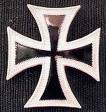30 December 2007
The Black Cross

I don't know why the complete transformation of one distinct thing to another thing is so fascinating. Maybe that is why RuPaul does so well with the drag thing,
Really, if I wanted to know about how a place can be transformed completely I could just ask someone from the Little Traverse Bay Band of the Odawa Indian clan what they think about the town of Harbor Springs, which sits haughtily on the bluff above their former tribal lands,
There is something about the rapidity of the transition, though, that adds to the fascination, and the Odawa have been watching for a few hundred years until they had the chance to build their Casino and get even.
Something of the same slow process happened in Konigsberg, which started as a ford across a river that debouches still into the gray waters of the Baltic Sea.
The town was founded in 1312 by the Teutonic Knights. Therein is a story all its own, which we abbreviate for the sake of clarity. In those days, the eastern Baltic was populated by Prussian tribes of Germanic stock. They refused, for a variety of reasons, to take Jesus as their personal savior, and their happened to be some armed theologians who were available to expand the Faith.
The Order of the German House of St. Mary In Jerusalem- the Teutonic Knights, for short- had been formed at the end of the 12th Century in Acre, Palestine. They wore white surplices over their armor with a black cross that is disturbingly familiar.
Back in the day, the Knights controlled the port tolls in Acre, but were forced to find a new mission after Christian forces were expelled from the Holy land by the Mamluk armies in 1291.
The Knights decamped to Translyvania, on the Amber Road of trade which ran from the Baltic to the Mediterranean. They defended the Kingdom of the Hungarians against depredations from the depredations of nomadic Turkish tribes. They were expelled from Hungary in 1225 for plotting with the Pope against the local kings, and had time and religious fervor on their hands. That is how they found themselves embarked on another grand crusade chartered by Holy Roman Emperor Frederick II, to spread the faith to the Old Prussian tribes of the eastern Baltic.
They did pretty well for themselves, digging themselves into the pagan land and rechristening it “Friedland,” or “peaceful land,” in the low German. They answered, in their interpretation of the chain of command, to no one but the Pope. They established strong urban economies at Konigsberg and Memel and hired mercenaries from across Europe to maintain vast brick castles in the Old Prussian lands. They even made themselves a naval power on the Baltic.
With the conversion of the Lithuanians to Christianity, the Knights increasingly found themselves engaged in conflicts with other Christian powers, which seemed to be a conflict with their basic mission statement. By the middle of the 15th century their power was broken by a Polish-Lithuanian alliance.
Trade had supplanted the crusading mentality, and the Baltic was ruled by the Hansa, an alliance of craft guilds in the city-states of the Germanys. The Grand Master of the Knights converted to Lutheranism in 1525, and became the Duke of Prussia.
The martial spirit of the Knights lived on, though, through the development of a splendid horse of war. Upon the founding of their religious state, the Knights had discovered that a hardy breed of horse was indigenous to the area. They called it the Schwaike, and the little horses became known for their endurance in crusading and general agricultural work. Over many years, the Schwaike mares were crossed with larger stallions of different breeds to meet the specific requirements of the Prussian State.
One of the most pressing needs was for cavalry horses. That is where my Ukrainian friend Taagie comes into the story, and the primary reason for this discourse about a place and things that no longer exist.
We will have to get to that tomorrow, but there are two great streams to the story. One is the militarism that is inherent to the Prussian State, inculcated in the national DNA, if you will. The other is the craftsmanship that involves the yellow semi-precious stone that is found in such abundance on the Baltic coast.
It made the artists of Konigsberg famous, almost as famous as the black cross emblazoned on the war flags of the Prussians. What they created from the amber was considered the sixth wonder of the world. Now, it is gone just as surely as the horses and the cross.
Copyright 2007 Vic Socotra
www.vicsocotra.com
Close Window